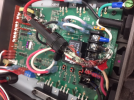The power circuit will blow at , lets say 30 amps. If there is an internal issue with the VFD, it may go up in smoke and when it has fully destroyed itself, still not have tripped the breaker.
When the instructions called for fusing all incoming power lines, that is because all power carrying lines need to be fuse protected at the VFD. Normally, you use a two fuse block and connect the block to the power terminals on the circuit board. I don't know that I have ever seen one done with that type in-line fuse holder. As long as the wire gauge is sufficient, it should work, but I suspect it was an automotive type fuse holder and not one with a sufficiently heavy wire for a 220 volt connection.
My recommendation is to get a two fuse block and connect it to the power from the switch on one side and the circuit board on the other. Mount the block in the cabinet near where the power cord comes in.



